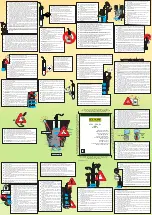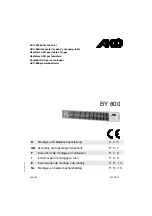
Residen al Electric Water Heater Use and Care Guide • 23
faucet will help the tank drain faster.
5
Remove the upper or lower
access panel on the water
heater, and then fold back the
insula on and remove the plas c
element/thermostat cover.
Figure 34 -
Access Panel
6
With the tank drained and
power o
ff
, remove the power
wires from the element you
intend to replace.
7
Remove the bad element using
an element wrench.
8
Make sure the new element is
the correct replacement by
referring to the water heater’s
data plate for voltage and wa age
informa on.
9
Clean the threads in the tank
opening with a rag. Insert the
new element equipped with a
rubber gasket. NOTE: Use a drop of
hand dishwashing liquid to lubricate the
gasket to help avoid damaging the
gasket as it is being ghtened. Tighten
with an element wrench.
NOTICE:
Do not turn power back on un l
the tank is completely full of water. For
complete instruc ons on
fi
lling the tank,
follow Step 8 in the Installa on sec on.
10
Re
fi
ll the tank by opening the
cold water supply valve. Make
sure a hot water faucet is open
and the drain valve is closed. Allow the
hot water to run full for at least three
minutes to make sure the tank has all
the air removed and is completely full
of water. Failure to perform this step
can cause the upper hea ng element to
burn out. Once you are certain the tank
is completely full of water, close the hot
water faucet.
Figure 35 -
Drain Valve
11
Check the newly installed
element for leaks. If a leak is
present, ghten the element
un l the leak stops. If you cannot stop
the leak, drain the tank and remove the
element. Inspect the gasket for dam-
age. If the gasket is damaged, replace
the gasket and re-install the element.
12
Once the element is success-
fully installed and there are no
leaks, replace the power wires,
thermostat cover, insula on, and access
panel. Make sure all wire connec ons
are ght. Replace the cover on the
electrical junc on box.
13
Restore power to the water
heater. It may take two hours
for the tank to heat up.
Replacing the Thermostat
WARNING! Working on an ener-
gized circuit can result in severe injury
or death from electrical shock. Turn
power o
ff
. Check wires with a non-con-
tact circuit tester to make sure power
is o
ff
. When you are
fi
nished, be sure
all covers are secured to reduce the
risk of
fi
re and electric shock.
To replace the thermostat, you’ll need
the following tools and supplies:
• A non-contact circuit tester. Always
turn power OFF
and check with a non-contact circuit tes-
ter before working on the water heater.
Figure 36 -
Upper and Lower Thermostats
• A replacement thermostat (available
at your local plumbing supplier).
Note that the upper and lower ther-
mostats are different (above). Some
models only have one thermostat.
• A business card to check the gap
between the thermostat and the tank
• Tape and a permanent marker to
mark the wires
• A flat blade and a Phillips screwdriver
Steps for Replacing the
Thermostat:
1
Turn the power OFF at the
circuit breaker or remove fuses.
NOTICE:
It is not necessary to drain the
tank to replace a thermostat.
2
Open the electrical junc on box
on top of the water heater. Using
a non-contact circuit tester, check
the power wires to make certain the
power is OFF.
Figure 37 -
Non-Contact Circuit Tester
MAINTENANCE






































